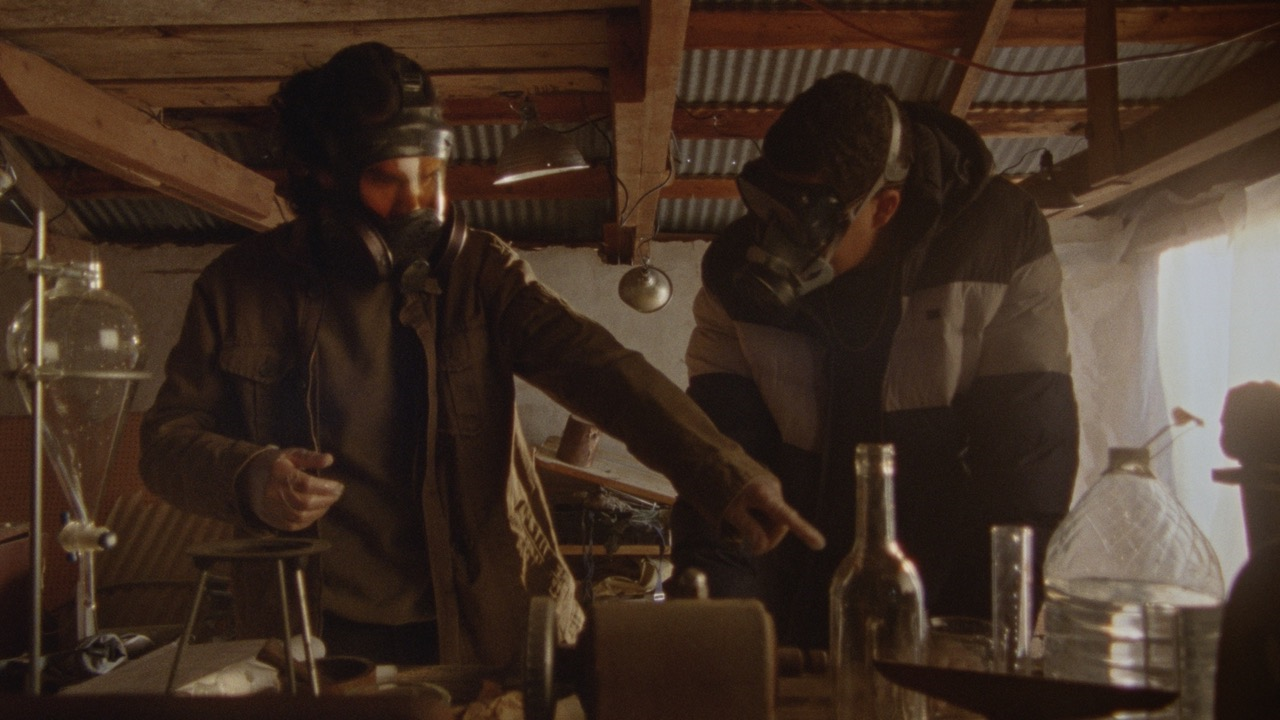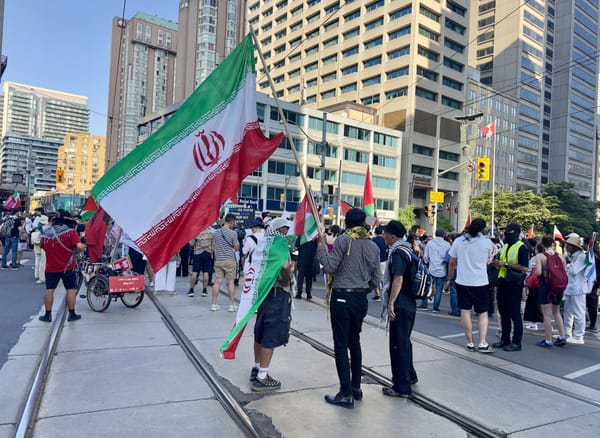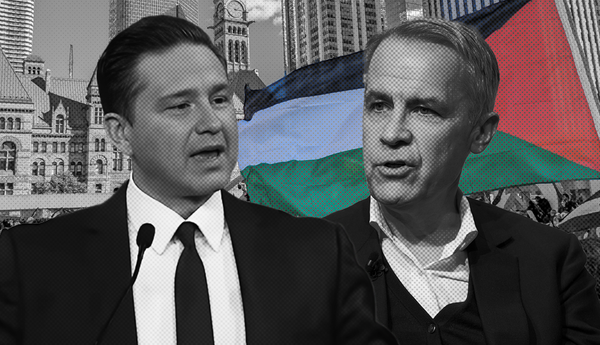For the first time since 2018’s Sorry to Bother You, the radical left has been gifted a decently funded and promoted movie in the form of Daniel Goldhaber’s How to Blow Up a Pipeline (HTBUAP). Fictionalizing Andreas Malm’s 2020 book by the same name, the TIFF-premiered and now theatrically-released film tightly narrates the story of a small and diverse crew of young working-class activists who are variously motivated to destroy an oil pipeline in West Texas.
Depicting a militant response to urgent subject matter via a classic heist format — plotting, mishaps, character flashbacks, a pulsing score — has predictably won over many fans. The overtly taboo quality of the film, cemented by warnings about it in FBI bulletins and energy regulator statements, has likely greatly added to the appeal, with countless Letterboxd reviews making the same coy joke about viewing it putting them on a government watchlist. It’s a perfectly timed cultural moment for an increasingly disaffected and restless demographic.
Most cultural products shouldn’t be read at face value. Artists often infuse their work with all kinds of murky dynamics — characters who are antiheroes, erratic or unreliable narrators, for instance, like in the similarly themed Night Moves (2013) or First Reformed (2017) — while audiences can in turn negotiate a variety of competing interpretations. Failing to grasp this can lead to vulgar reductions of a text’s morality to the creator and/or characters, and marginalize the possible merit of art that unsettles, bores, or confuses.
With that said, HTBUAP is one of the few movies that we can be fairly confident in evaluating as near unmediated prescription: its content is brazenly didactic and expository, much of its polemical dialogue and messaging is lifted straight from the book (aside from one character who’s tasked with providing occasional half-hearted pushback), and the ending is as close as one can get to an outright call to action short of just writing a command on the screen (it’s about as subtle). Meanwhile, Malm himself called it a “game changer” for the movement, while book publisher Verso has leveraged it for another marketing push. Although its director and actors have modestly hedged their beliefs in the media, likely for legal reasons, it’s clearly intended as a tool to motivate escalation in tactics to fight for a just and liveable world. This approach clearly resonates with many viewers, and screenings have been used to raise funds for vital anti-repression work such as the Atlanta Solidarity Fund.
There’s nothing inherently wrong with this goal: global socioecological crises are rapidly worsening, property destruction is a legitimate and often effective tactic, and many legendary films have been made about radical political struggles. The problem with HTBUAP is that its concrete prescriptions are mortifyingly daft. Like the book that it’s loosely based on, the underlying premise is utterly illogical, categorically refuses to engage with actual movement history and in turn makes a mockery of the need for tight organizing to reduce the very real risk of vicious state repression. Goldhaber has explained it as having “fantastical elements” and “a bit of a Hollywood ending” that isn’t supposed to provide “an exactingly accurate portrayal of what activism looks like today.”
Yet much of the left punditry’s discourse about it doesn’t seem to adequately account for this discrepancy, instead reading it as a borderline prophecy of what can, must and will be done; reviews praise it as the film “everyone needs to see right now” and one that “levels Hollywood’s dehumanizing gaze on a worthy target.” While a vast majority of its viewers won’t do anything of the sort (whether due to smarts, fear or that “the film performs our anti-capitalism for us”), HTBUAP’s message is rolling out in a context of a severe lack of radical organizing in many places and runs the real risk of promoting highly ineffective and counterproductive adventurism. As such, its central intersecting claims need to be scrutinized.
The Problem Of Abundant Oil
Sabotage and property destruction is an entirely valid form of resistance. This isn’t simply a moral argument but a historical one, with such tactics playing a central role in many struggles for national liberation, radical left politics and ecological defence (with the latter most notably in the form of Animal Liberation Front, Earth Liberation Front, and Earth First!, which Malm slanders in his book and the film simply ignores). The question at hand isn’t whether the tactic is justified but whether it’s effective in concrete contexts and in turn warrants the sizeable risks of repression and blowback.
Historically, most attacks on property — including vandalism, sabotage, animal liberation, arson and explosives — have been highly precise in nature, attempting to directly stop or delay a harmful activity. Analyzing the relatively rare use of arson by the animal and earth liberation movement, scholar Michael Loadenthal writes that “when such a tactic is chosen, it appears to target locations viewed as integral to production and distribution, not solely retail locations typically targeted for more symbolic (yet costly) vandalism.” This same type of laser focus is exhibited by the courageous militancy of Palestine Action in the United Kingdom, which has been waging a multi-year direct action effort, including sabotage and property destruction, against local factories and businesses linked to murderous Israeli drone manufacturer Elbit Systems. The objective with such tactics isn’t principally to pressure, persuade or raise consciousness (although these can certainly be welcome byproducts), but to materially prevent something from happening or continuing.
It may sound like this approach aptly describes HTBUAP, in which several characters work to safely detonate an oil pipeline as a response to climate chaos and socioecological devastation. But aside from the Wiebo Ludwig-like and almost certainly Trump-voting character who improbably joins the motley crew in protest of government seizure of his land to build a pipeline, the underlying motivation doesn’t ultimately relate to a specific piece of infrastructure (the characters arrive in West Texas from all over the country for the task). Rather, the repeatedly stated intention is for the act, and others inspired by such a propaganda of the deed, to dramatically raise oil prices and supposedly make the commodity unviable in the marketplace. The attack’s aspirations thus not only transcend the local but the regional, national and even continental.
While this arguably grasps the multiscalar nature of the climate crisis, it profoundly misapprehends the sheer extent and resiliency of the global oil industry itself. Without going too far down the rabbit hole, the system can deftly accommodate emergency situations, with the U.S. Strategic Petroleum Reserve housing more than 370 million barrels of oil and OPEC reporting spare production capacity of more than 3 million barrels a day. Further, oil pricing and production is far from a simple matter of supply and demand or supposedly finite reserves — a trap that “peak oil” theorists frequently fell into — but is rather shaped in exceedingly complex ways by competition, profitability, financialization, and political conditions.
“The problem of oil,” scholar Mazen Labban writes, “is not its scarcity but its abundance,” with producers and states constantly working to prevent its overproduction, which reduces prices and profitability. Taking out one or even several high-capacity pipelines may cause temporary fluctuations in pricing, but oil’s notoriously inelastic demand due to its ongoing importance as an energy-dense transportation fuel and petrochemical feedstock would be quickly filled from other sources, including the possibility of new or expanded investments. Such acts will annoy specific capitals, surely, but nothing about it threatens the system as a whole; in fact, higher prices can generate immense windfall for producers.
Malm takes a slightly different approach in the book. He doesn’t frame sabotage as an end in itself but rather a method of deterrence to “let the capitalists who keep on investing in the fire know that their properties will be trashed” and to put pressure on the bourgeois state “to proclaim the prohibition and begin retiring the stock” of fossil fuel infrastructure. This chimerical proposal, hinging on a social democratic view of the neutral and pliable capitalist state, has been best critiqued by Arnold Schroder of Fight Like an Animal podcast: “Ultimately, his strategy is to sabotage his way into the hearts and minds of the people who currently inhabit the power structure. This is just one of the crazier varieties of liberalism I’ve ever encountered: this is sabotage liberalism.”
Despite masquerading as being deadly serious about the climate crisis, both the book and movie advance the same kind of nonsensical roadmaps that don’t even begin to grapple with the immensity of the circumstances. Such “sabotage liberalism” actively mystifies the real opportunities and constraints of property destruction.
‘The Green Scare Has Not Broken Us, But It Has Changed Us’
These choices take on even greater gravity when it comes to the film’s borderline comical treatment of activist security culture and state repression. Once again, this is a fictional movie, not a documentary, allowing naive and nihilistic characters to make less-than-perfect decisions. But there are few widely celebrated depictions of sabotage, so this content matters to some degree given the film’s elevation in the broader radical left discourse, and its claims to realism (which include, no joke, a U.S. Bureau of Counterterrorism higher-up serving as technical advisor).
To put it bluntly, it’s questionable if anyone involved in this movie’s production has ever participated in an activist space requiring caution and preparation. Its supposedly hardcore characters — who use Signal and remove batteries from phones or put them in fridges before discussing plans — proceed to conduct highly illegal acts in broad daylight, without masks or face coverings, and using each other’s actual first names. Characters are recruited to the cause through some of the most suspicious means imaginable, including DMing an amateur bombmaker uploading how-tos on TikTok to ask if he can talk about a “project” and approaching someone flipping through Malm’s book in a store to casually discuss property destruction. Most egregiously, the crew not only knowingly includes an FBI informant in the plan but successfully outwits bumbling federal agents and local police who are tricked into immediately believing that only two of the characters were involved in the sabotage, thus absolving the snitch (following Malm’s advice that such sacrifices are necessary, both people willingly gave themselves up to rot in federal prison for the cause and to dubiously set a legal precedent).
Cops and agents are far from infallible or omniscient and can be thwarted, at least for a time, with proper preparation, training, and security culture. But, echoing the book’s tone, HTBUAP essentially ignores the problem of repression altogether, as if the capitalist state will capitulate before it becomes too much of an obstacle. This not only makes for a boring plot requiring heavily contrived tension — a heist going off without a hitch isn’t exactly thrilling, unless you’re Michael Mann — but it also does a deep disservice to the recent and ongoing history of the Green Scare, “critical infrastructure” bills, and targeted crackdowns against land and water protectors, including the recent police execution of Tortuguita. As Earth First!er Madeline ffitch wrote in an essential critique of the book, “the Green Scare has not broken us, but it has changed us. We have had to learn how to exercise what we call ‘security culture,’ a set of practices to outwit surveillance. If we know people who say they want to slash SUV tires or sabotage coal mines, we remind them not to talk to us, or anyone else, about it.” These particular characters may not care about their lives or believe in a future — this much is explicitly stated by more than one of them, who are dealing with immense personal tragedies — but such incaution has no place in any real revolutionary struggle, whether it attacks property or not.
This is especially true because, regardless of what fantasies Malm and the filmmakers want to dream up, destroying oil infrastructure will likely not be a widely popular act. Oil is produced for incredible profit, of course, but it underpins a great deal of daily life as a fuel for driving, flying and transporting almost all commercial goods, along with serving as a main input (alongside natural gas) for plastics, synthetics, and chemicals. As Bue Rübner Hansen notes, Malm’s book “bypasses the need for a critique of the intertwinement of middle and working class reproduction with fossil capital, both in the form of everyday needs and aspirations.” Conversely, Malm unhelpfully divides emissions into “luxury” and “subsistence” and categorically condemns any action that may inconvenience working-class commuters, apparently convinced that oil is mainly something flared into the sky by oil corporations and private jets rather than profoundly enmeshed through our lives and desires.
This reality certainly doesn’t mean that such conditions don’t need to shift dramatically and quickly, including the massive expansion of fare-free and high-quality public transit. But the framing of the crisis as a pure binary of Big Oil vs. an ecological working-class engaged in self-defence (with Malm frequently pointing to armed national liberation struggles against colonial powers as examples) massively overstates the popular backing that large-scale sabotage will likely have and in turn vastly underestimates the support that brutal and racist state repression may receive. We all “remain tragically soaked in oil,” to again quote Hansen, requiring a far wider proliferation of an anti-racist/colonial/imperialist eco-socialist politics, despite the seemingly impossible odds.
The Revolution Won’t Be Hollywoodized
The tone of HTBUAP, both as a book and movie, is belligerently urgent. The neon cover and snappy writing of the book joins the fast cuts and Safdie brothers-inspired score to impose the same conclusion: we don’t have any more time for thinking or theorizing but must instead allow ourselves to feel a visceral terror and do what we all know must be done. Oil infrastructure is destroying us, therefore we must destroy the oil infrastructure. Anything else is just talk.
Ironically, we simply don’t have time for this “sabotage liberalism.” By advocating for high-risk actions that have no coherent or remotely likely path to success — with the hope that such sacrifice will inspire others to do the same and eventually lead to the state conceding to rapid decarbonization demands — these supposedly radical products instead potentially hamper actual revolutionary work.
Asides from the fact that all recent sabotage of energy infrastructure seems to have been done by either the U.S. or fascists, the greatest irony of HTBUAP is that Malm’s emphasis on sabotage being linked and guided by radical mass movements is entirely abandoned in the movie for individual adventurism solely united via social media (and an FBI informant). Such a regression fulfills Leon Trotsky’s 1911 condemnation of propaganda of the deed “precisely because it belittles the role of the masses in their own consciousness, reconciles them to their powerlessness, and turns their eyes and hopes towards a great avenger and liberator who some day will come and accomplish his mission.”
The reality is that any prospect of socialist transition can only result from painfully slow, steady, careful organizing, whether in the form of Earth First!-style “direct-action solidarity network[s]” or creating a revolutionary party on the basis of a “Climate Leninism” for “building long-term alliances and training cadre” alongside actually existing struggles. HTBUAP attributes a supposed lack of militancy to moral or ethical opposition to property destruction. But many people are in fact willing to take significant risks in activism if there’s infrastructure in place to support them before, during and after, and if there’s a greater-than-zero chance of it actually having a meaningful impact (rather than merely a desperate but ephemeral symbolism). The problem is far more a lack of organizing than cowardice or liberalism. While diverse in specifics, such organizing inevitably requires long-term commitments to the unsexy work of outreach, care work, logistics, internal debates, comms, preparing for and responding to repression (including infiltration, raids, prisoner support, legal funds, and plea deal betrayals), and much more.
None of this makes for especially captivating reading or watching. And this is perhaps the greatest flaw of HTBUAP as an ever-growing media franchise: it hawks a vision of thrilling spectacle in the name of dire urgency when the actual work required necessitates profound patience and discipline over the course of years, decades, and even lifetimes.
Can art and polemics play a role in helping cultivate such commitment, despite formal restraints or contradictions? Of course. But the “hope” and “feeling of possibility” that Goldhaber worked to generate with this film, and Malm with his book, isn’t grounded in material conditions, necessary commitments, or even an on-ramp to effective property destruction. It’s a “sabotage liberalism” that at worst will goad people into getting jailed or killed for no gain and at best waste precious time distracted by an adventurist “solution” that refuses to learn from the past or organize for a revolutionary future.
It’s obviously fine to seek out momentary catharsis in pandering media — evangelicals do the same with God’s Not Dead — but we can’t afford to treat it as anything beyond that. The situation is simply far too urgent.






